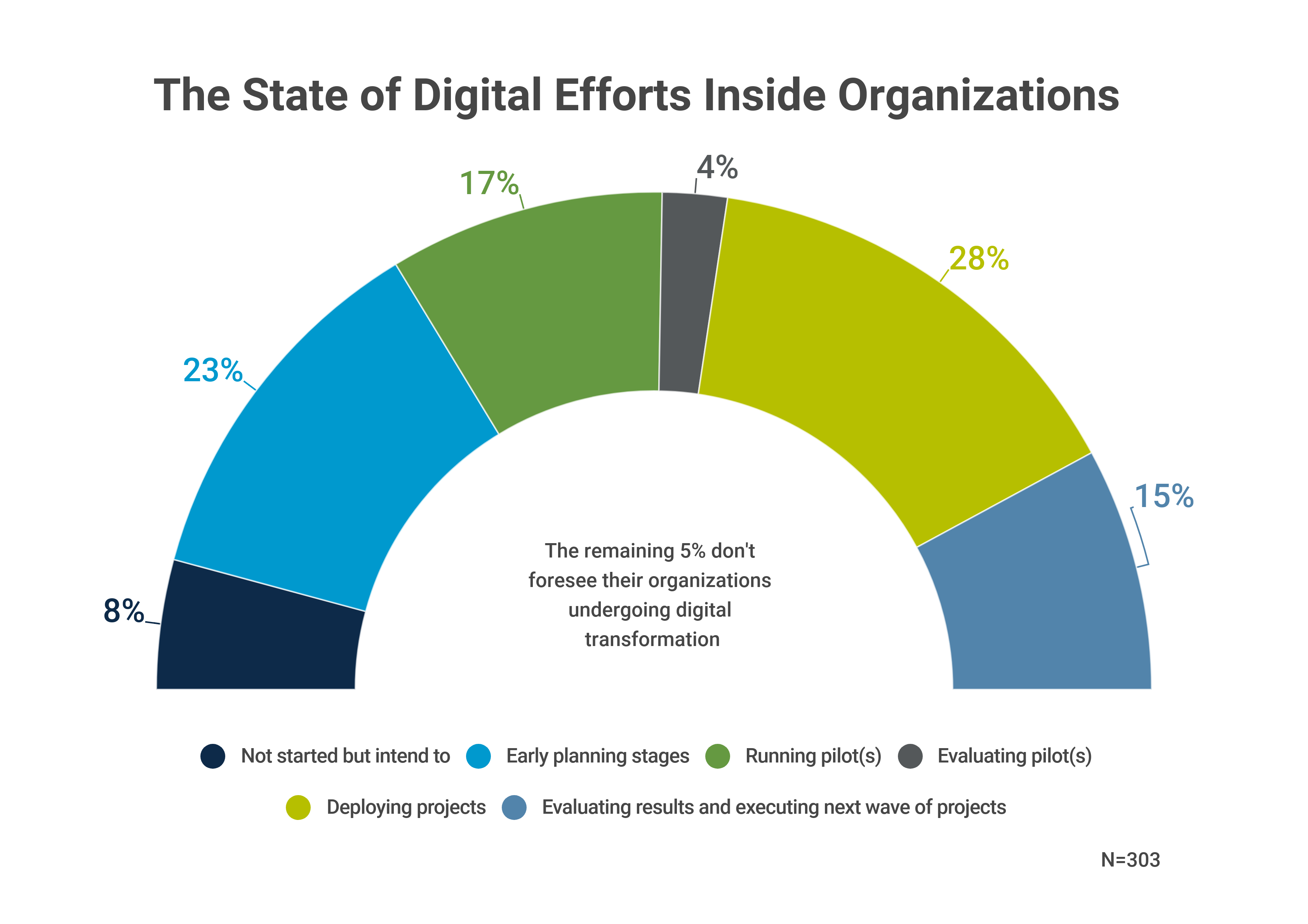 Everywhere you look, companies are experimenting with digital transformation. According to APQC’s Measures of Digital Transformation research, around half are in the early stages of digital implementation: 17 percent are running pilots, 4 percent are evaluating recently completed pilots, and 28 percent are deploying their first wave of digital projects. I’m featuring these digital maturity statistics as our June KM metric of the month in an effort to implore knowledge managers to pay attention to this space.
Everywhere you look, companies are experimenting with digital transformation. According to APQC’s Measures of Digital Transformation research, around half are in the early stages of digital implementation: 17 percent are running pilots, 4 percent are evaluating recently completed pilots, and 28 percent are deploying their first wave of digital projects. I’m featuring these digital maturity statistics as our June KM metric of the month in an effort to implore knowledge managers to pay attention to this space.

Whether your organization is deep in the throes of digital transformation or just dipping its toe into the water, KM should be part of the strategic conversation about emerging digital capabilities. KM has always involved technology, but the relationship between KM activities and underlying systems is changing. Employees have new options to collaborate in real time, surface relevant information and expertise in the flow of their work, and seamlessly share what they know and have created with others. If the KM function is not on top of these changes and steering how they manifest across the enterprise, it is in danger of being surpassed by the CIO office, digital workplace team, or other internal groups pedaling more data- and tech-savvy solutions to the organization’s knowledge-related problems.
The good news is that knowledge managers bring a lot to the table when it comes to digital transformation. They understand the evolution of knowledge systems within the organization, and even more importantly, they know what it takes to get employees to actually use those systems. But they need to start putting this expertise to work by exploring new knowledge technologies and testing their feasibility and impact.
What Are Digital Transformation Pilots in KM?
Of course, it’s not enough to simply pilot new technology for KM: You also need to choose the right pilots. APQC has talked to a wide variety of KM teams testing automation, “smart” technology, and more. While some are experimenting with cool tools for their own sake, the best examples are more targeted. They focus on specific use cases to make knowledge sharing more efficient or solve specific, pre-identified problems in the flow of knowledge.
We’ve seen some great pilots for automating back-end KM processes, such as using autoclassification to assign metadata and natural language processing and RPA to automatically translate assets between languages. Others are using AI to help clean up content repositories by flagging items that should be updated, retagged, or archived. But the vast majority of KM digital projects focus on the end-user experience and, in particular, making it faster and easier to surface relevant knowledge.
Tools like cognitive search and smart recommendation systems show great promise in improving findability and suggesting resources based on a user’s context. They can also connect employees with colleagues who are doing similar work in other units or locations, opening up new avenues for collaboration.
In addition, some interesting pilots use chatbots to make employees aware of available resources in a more natural, conversational way. One manufacturing company is testing the use of chatbots in its technical communities of practice. When a member posts a question to the community forum, the chatbot pops up with potential answers, links to relevant content, and recommended experts to consult. The bot’s responses appear as part of the conversation thread. This means that experts and experienced members save time answering simple questions that the bot can handle easily, but they can still jump in if the bot provides an incomplete, confusing, or incorrect response.
Selecting and Planning Pilots
With so many capabilities and tools out there—how do you figure out what to pilot? APQC suggests three criteria to focus on when selecting KM pilot projects. This advice applies to any KM pilot, but it is particularly apt for evaluating new digital applications.
- Aligned with overarching strategic objectives. The technologies you choose to experiment with should have the potential to enhance core business processes, solve high-priority problems, or otherwise impact the business and employees in a meaningful way. Look back at your KM business case and value proposition. Why does the organization invest in KM, and what needs is KM expected to address? If you haven’t reevaluated your KM strategy and business case recently, you may need to conduct some stakeholder interviews to understand the specific problems that are keeping business leaders up at night and where they want KM to focus.
- High probability of success. A project’s potential for success is necessarily subjective, especially before launch. And when working with new technologies, it may not always be clear what success even looks like. But it’s still important to clarify what sponsors and stakeholders are looking for and then select tools most likely to deliver the desired results. As part of this evaluation, think about whether the results of the pilot can be easily measured and communicated. For example, AI deployments can be time- and cost-intensive depending on their scope, but a project that will take thousands of man-hours over three years to deliver any value may not be the best choice.
- Scalable and likely to generate transferrable learnings. The projects you choose do not need to apply to the entire enterprise to be successful. In fact, the most urgent needs and pain points may relate to a particular function or line of business. But when assessing potential pilots, it’s still important to think through whether an implementation will be scalable and how the broader organization might benefit from what you’re developing. There is a fine line between tailoring the tool you’re piloting to the needs of a specific user group and over-customizing it, thus rendering it inapplicable to other parts of the business.
APQC's Criteria to Select KM Projects can help members evaluate and compare potential digital transformation projects. If the pilots you choose will require investments in new technology (#6 on the worksheet), it’s all the more important to ensure that the other criteria are met.
Once you’ve selected your digital projects, I recommend looking at Developing a KM Pilot Project and APQC's KM Project Planning Worksheet. These resources walk through the details of selecting a design team, assessing potential risks associated with your project, and developing and action plan to guide the work and manage expectations.